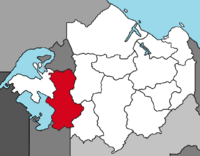Frankenburg: Difference between revisions
Neuleinster (talk | contribs) |
Neuleinster (talk | contribs) |
||
| Line 121: | Line 121: | ||
===Executive=== | ===Executive=== | ||
The executive is led by the state government of Frankenburg, which consists of the Frankenburgian governors and the state ministers. The governor is elected by the state chamber with a majority of its members without debate in a secret ballot for the entire legislative period. The governor appoints and dismisses state ministers. He also appoints a minister as his deputy. The state chamber can only depose the governor through a constructive vote of no confidence. | The executive is led by the state government of Frankenburg, which consists of the Frankenburgian governors and the state ministers. The governor is elected by the state chamber with a majority of its members without debate in a secret ballot for the entire legislative period. The governor appoints and dismisses state ministers. He also appoints a minister as his deputy. The state chamber can only depose the governor through a constructive vote of no confidence. | ||
===Frankenburgian state government=== | |||
{|class="wikitable" style="text-align:center" | {|class="wikitable" style="text-align:center" | ||
|- | |- | ||
Revision as of 06:17, 27 November 2022
Frankenburg
Frankenburg | |
|---|---|
 Frankenburg located in Besmenia | |
| Country | Besmenia |
| Capital | Berkafurt |
| Government | |
| • Type | Parliamentary republic, partially sovereign member state of a federal state |
| • Body | State Chamber of Frankenburg |
| • Governor | Christina Liebetrau (BVP) |
| • Governing parties | BVP/SDU |
| • Federal Senate votes | 4 (of 64) |
| Population (2021) | |
| • Total | 2,844,953 |
Frankenburg (Besmenian: Frankenburg) is a federal state located in Besmenia.
Geography
Population
Frankenburg is the least populated state in Besmenia with a population of 2,844,953.
History
Politics
Frankenburg is referred to as a swing state, which usually has a signal character in nationwide elections. The BVP dominates in the rural areas of Frankenburg, the FBBP in the industrial regions and in the railway junctions. The BVP, which was the strongest party except the period 1981-1999, dominated state politics. Between 1981 and 1999, the FBBP, with Franz Gauthier as governor, was the strongest party in Frankenburg.
Executive
The executive is led by the state government of Frankenburg, which consists of the Frankenburgian governors and the state ministers. The governor is elected by the state chamber with a majority of its members without debate in a secret ballot for the entire legislative period. The governor appoints and dismisses state ministers. He also appoints a minister as his deputy. The state chamber can only depose the governor through a constructive vote of no confidence.
Frankenburgian state government
|
Governors of Frankenburg since 1967 | ||||||
| No. | Portrait | Name | Term of office | Political party | Election | |
| 1 | File:Ulf Engelbert.png | Ulf Engelbert (1909-1994) |
4 November 1967 |
26 July 1975 |
BVP | 1967 1971 |
| 2 | File:Konstantin Herbmann.png | Konstantin Herbmann (1920-2002) |
26 July 1975 |
31 July 1981 |
BVP | 1975 |
| 3 | File:Franz Gauthier.png | Franz Gauthier (1936-2020) |
31 July 1981 |
28 July 1999 |
FBBP | 1981 1987 1993 |
| 4 | File:Jörg Hofstadt.png | Jörg Hofstadt (1952-) |
28 July 1999 |
16 March 2013 |
BVP | 1999 2005 2011 |
| 5 | File:Anton Scholzer.png | Anton Scholzer (1960-) |
16 March 2013 |
29 July 2017 |
BVP | - |
| 6 | 
|
Christina Liebetrau (1969-) |
29 July 2017 |
Incumbent | BVP | 2017 |
Legislature
The legislature is the State Chamber of Frankenburg, which is elected every six years using the open list proportional representation. The parliament of Frankenburg consists of 89 members.
Elections
Local government
Frankenburg is divided into 15 districts (Landbezirk).

